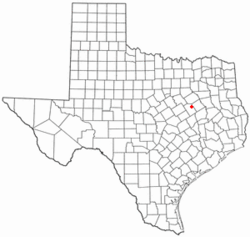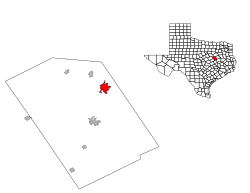Mexia, Texas facts for kids
Quick facts for kids
Mexia
|
|
|---|---|
| Mexia, Texas | |
| Motto(s):
A great place to live, no matter how you pronounce it
|
|

Location of Mexia, Texas
|
|
 |
|
| Country | United States |
| State | Texas |
| County | Limestone |
| Area | |
| • Total | 7.30 sq mi (18.90 km2) |
| • Land | 7.20 sq mi (18.64 km2) |
| • Water | 0.10 sq mi (0.25 km2) |
| Elevation | 532 ft (162 m) |
| Population
(2020)
|
|
| • Total | 6,893 |
| • Density | 1,020.28/sq mi (393.95/km2) |
| Time zone | UTC-6 (Central (CST)) |
| • Summer (DST) | UTC-5 (CDT) |
| ZIP code |
76667
|
| Area code(s) | 254 |
| FIPS code | 48-47916 |
| GNIS feature ID | 2411092 |
Mexia (![]() i/məˈheɪə/ mə-HAY-ə) is a city in Limestone County, Texas, United States. In 2020, about 6,893 people lived there.
i/məˈheɪə/ mə-HAY-ə) is a city in Limestone County, Texas, United States. In 2020, about 6,893 people lived there.
The city's name is often mispronounced. Because of this, Mexia has a fun motto: "A great place to live, no matter how you pronounce it." The city was named after General José Antonio Mexía. He was a Mexican hero for the Republic of Texas Army during the Texas Revolution. The town was started near his family's land.
Near Mexia, you can visit Fort Parker Historical recreation. There are also the Confederate Reunion grounds. Another important place is the Mexia State Supported Living Center. This center was once a prisoner of war camp during World War II. It held members of Field Marshal Erwin Rommel's Afrika Korps.
Mexia is also home to the Mexia Public Schools Museum. This museum teaches about the history of the local school system. Famous model Anna Nicole Smith went to school in Mexia. The city also hosts a big Juneteenth celebration every year.
Contents
Geography and Location
Mexia is located in the state of Texas. It is in Limestone County. The city covers about 5.2 square miles (13.5 square kilometers) of land.
People of Mexia
| Historical population | |||
|---|---|---|---|
| Census | Pop. | %± | |
| 1890 | 1,674 | — | |
| 1900 | 2,393 | 43.0% | |
| 1910 | 2,694 | 12.6% | |
| 1920 | 3,482 | 29.3% | |
| 1930 | 6,579 | 88.9% | |
| 1940 | 6,410 | −2.6% | |
| 1950 | 6,627 | 3.4% | |
| 1960 | 6,121 | −7.6% | |
| 1970 | 5,943 | −2.9% | |
| 1980 | 7,094 | 19.4% | |
| 1990 | 6,933 | −2.3% | |
| 2000 | 6,563 | −5.3% | |
| 2010 | 7,459 | 13.7% | |
| 2020 | 6,893 | −7.6% | |
| U.S. Decennial Census | |||
In 2020, Mexia had 6,893 residents. There were 2,487 households living in the city. About 1,586 families called Mexia home.
The people of Mexia come from many different backgrounds. In 2020, about 32% of residents were White (not Hispanic). Around 30% were Black or African American (not Hispanic). About 34% of the population was Hispanic or Latino.
Many households in Mexia have children under 18. The average household had about 2.6 people. The average family had about 3.2 people.
History of Mexia
Mexia was founded in the 1800s. It started near the Fort Parker settlement. This area is where the rolling hills of the Great Plains begin. These hills were once home to large buffalo herds. Native American tribes, like the Comanche, hunted buffalo here. Many old hunting tools have been found in the creeks around Mexia.
The Comanche tribe sometimes had conflicts with the early white settlers. A famous event was the abduction of Cynthia Ann Parker from Fort Parker. She was nine years old when the Comanches took her. Cynthia Ann Parker grew up among the Comanche people. She became the mother of Quanah Parker, who was the last Comanche war chief.
Mexia is located where three important highways meet. These are U.S. Highway 84 and State highways 14 and 171. The town was officially started in 1870. Lots of land were sold in 1871 when a railway was built nearby. The first post office opened in 1872. Mexia became an official city in 1873. J.C. Yarbro was the first mayor.
By 1880, Mexia had schools, churches, and many businesses. Its population grew to about 1,800 people. By 1885, the town had an opera house and two banks.
The Oil Boom
In 1912, a company was looking for natural gas. After many tries, they found a huge natural gas deposit. Then, in 1920, the Mexia oilfield was discovered! This caused the city to grow very quickly. The population jumped from 3,482 to almost 35,000 people.
This rapid growth was hard for the city to manage. For a short time in 1922, the city was under martial law. This means the military helped keep order. 1922 was the best year for oil production in Mexia. After the oil boom, the population went down. But the money from the boom helped the city until the 1930s.
During the Great Depression, many people left Mexia to find work. In 1942, a camp for prisoners of war was built in Mexia. After the war, in 1947, this facility became the Mexia State School. This school became one of the main employers in the community.
Education
Students in Mexia attend schools in the Mexia Independent School District.
Local Schools
- A.B. McBay Elementary School
- R.Q. Sims Intermediate School
- Mexia Junior High School
- Mexia High School
Before schools were integrated, there were also:
- Woodland High School (for African-American students)
- Paul Lawrence Dunbar High School (for African-American students)
Higher Education
- Navarro College has a campus in Mexia.
Notable People
Many interesting people have connections to Mexia:
- Les Baxter, a musician and composer
- Kelvin Beachum, an NFL football player
- Quentin Durward Corley, a judge
- Bill Crider, a novelist
- W. C. Friley, a clergyman and educator
- Henry Cecil McBay, a chemist
- Ynés Mexía, a botanist
- Washington Phillips, a singer
- Ray Rhodes, an NFL player and coach
- Anna Nicole Smith, a famous model and actress
- Daniel Wayne Smith, son of Anna Nicole Smith
- Allen Stanford, a financier
- Lee Wilder Thomas, an oilman
- Cindy Walker, a songwriter and singer
Climate
Mexia has a warm climate. Summers are hot and humid. Winters are generally mild to cool. This type of weather is called a humid subtropical climate.
See also
 In Spanish: Mexia (Texas) para niños
In Spanish: Mexia (Texas) para niños

